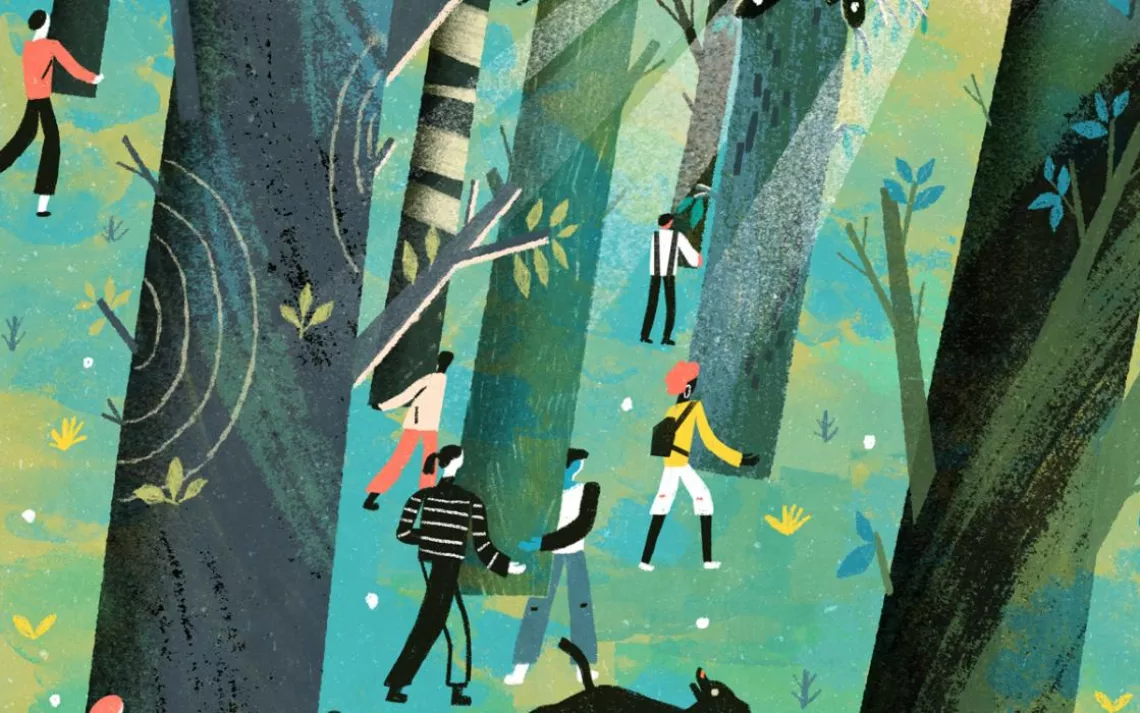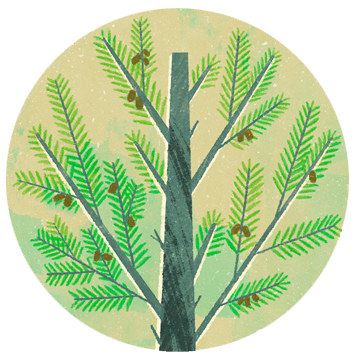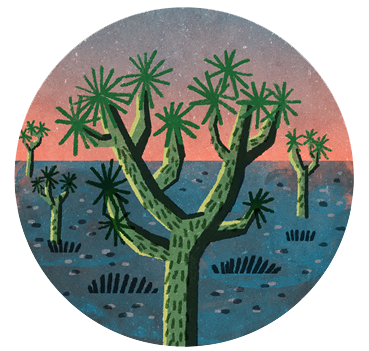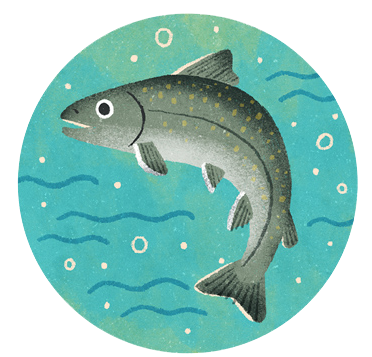Can We Help Our Forests Prepare for Climate Change?
And if we can, what's the right way to do it?

Illustrations by Wenjia Tang
ON A DECOMMISSIONED naval base in Maine owned by Acadia National Park, about a thousand tree seedlings stand inside a series of wire enclosures, corralled like farm animals.
Nicholas Fisichelli, forest ecology director at the Schoodic Institute, a nonprofit that functions as a research center for Acadia, walks through the plots of baby trees. They are laid out neatly in a grassy clearing, beside a former infirmary that has been converted into a science building. Lanky and bespectacled, he stoops to peer at the rows of new leaves and delicate stems. One group of plots is a test to see whether seed sown on the ground will sprout in this environment. Other sections are full of seedlings from nursery stock. Collectively, the plots are part of a radical experiment: a wide-ranging search for trees that will be able to survive in this national park decades from now—when things get hotter, drier, and much more uncertain.
Beyond this research field, dense forests—dominated by native trees like the dark, bristly red spruce and balsam fir and slender paper birch—spread across Acadia from one rocky shore to the other. But according to multiple projections on the likely impacts of climate change here, many of these trees could dwindle or die off in a matter of decades, leaving the park vulnerable to invasive weeds and bereft of important species that provide habitat to wildlife.
In response, over a year ago, Fisichelli, the project's lead researcher, and scientists with the National Park Service launched a search up and down the mid-Atlantic for tree species that might both survive Acadia's current harsh winters and tolerate the hotter conditions that will almost certainly exist in the future. The scientists planted the exotic trees here, alongside seedlings from species that already grow in the park. Since then, through an icy winter and two unusually dry summers, researchers have regularly walked through this plot, noting how the young trees are faring.
Until recently, most scientists and managers in national parks would never have considered an experiment like this. For decades, Park Service policy recommended that managers avoid meddling in nature, except for the express purpose of repairing damaged ecosystems or removing traces of human influence. Lifting a species from its current range and dropping it into an entirely new and unfamiliar ecosystem—a process known as assisted migration—is unorthodox and controversial. A species that is beneficial in one kind of ecosystem might be a pest or a scourge in another. History abounds with cautionary tales. For example, the black locust tree, which is native to the Ozarks and the Appalachians, turned into an aggressive invader when it was planted farther north, clustering into dense, thorny tangles all over New England.
But climate change is already triggering pest invasions and tree die-offs in many national parks and creating tough conditions for some plants and animals, including those that are at risk of extinction. Given these trends, many Park Service managers feel that the ecosystems they are charged with protecting will need extra help to weather what's coming. Often, scientists discuss assisted migration as a means of saving a particular plant or animal that might no longer be able to live in its historic range—like the American pika, endemic to high-alpine areas of the American West, and the giant sequoia of the Sierra Nevada. In Acadia, park scientists are concerned not just with what species might disappear from the park but also with what might arrive to take their place. They are thinking about what kinds of trees the park will need in order to keep its ecosystems healthy in 50 or even 100 years.
Inside Fisichelli's plots, some of the southern transplants are already leafy and assertive, crowding against one another as they compete for the midsummer sunlight. A seedling of a tulip tree (a species that naturally ranges from Florida to Vermont but has yet to migrate to Maine) has grown to about a foot and a half. It lifts its fat, pointed leaves alongside the slender stems of a pitch pine, a native of Acadia.
Other trees have failed. Sweet gum, a species with star-shaped leaves that is common from the Carolinas to the Gulf of Mexico, sprouted vigorously in the summer of 2017 but withered in the winter cold. Now its leaves are brown and crinkled, like folded moth wings. Fisichelli has three other sets of plots at different locations throughout the park. Others are higher, windier, warmer, or drier than this one. Different species have excelled or struggled at each, though fair-weather trees like the sweet gum have withered in the Maine winter freeze at every location.
The wire enclosures keep hungry animals from devouring the young trees. "Snowshoe hares are like sharks circling these things," Fisichelli says. The arboreal residents of these plots also aren't allowed to fraternize with the wild trees of the forest just a few feet away. If any seedling is precocious enough to grow flowers at this young stage, Fisichelli or one of his crew will snip off the buds well before the tree can produce a seed. No one who works inside Acadia is ready to offer these trees a permanent position here. This will be a long screening process.
ACADIA'S INTEREST in assisted migration began a few years ago, when new research emerged that made it clear that the park's forests could be headed for serious trouble. Since 2007, the U.S. Forest Service has published a set of models and maps called the Climate Change Tree Atlas, an effort to predict what trees might be able to thrive in which locations as local and regional climate conditions change. Five years ago, Fisichelli—then employed at the National Park Service's Climate Change Response Program in Fort Collins, Colorado—applied those predictions to more than 100 parks, including Acadia.
The results were sobering. Acadia's most important and common tree, red spruce, would lose about half its living space in the park. Eight other forest tree species native to Acadia, including northern white cedar and balsam fir, would also forfeit substantial portions of their ranges. Four native trees—tamarack, white and black spruce, and balsam poplar—would probably be extinct within the park by the end of the 21st century.
In the scientific community, there has been much discussion but few field tests of assisted migration, especially relocations over large distances. Sally Aitken, a plant geneticist at the University of British Columbia, has planted whitebark pine—a tree of the Rockies and the Mountain West that is now threatened by a disease called blister rust—in a remote location in the northern part of the province, far above its normal range. A group of grassroots activists stirred controversy a decade ago when they moved endangered Florida torreya trees to locations in North Carolina and as far away as Ohio.
The Park Service is not the only federal agency considering whether it may be necessary to relocate tree species. The Forest Service has launched trials of assisted migration for commercially valuable tree species at study sites in five regions. But the Park Service, an agency long focused on lofty conservation goals, has especially cautious standards for what species should be planted inside national parks.
As the Park Service wrestles with the vast crisis of climate change, some within the agency question their role: Should they be taking a more active hand in deciding what nature or wilderness will look like decades from now? Or should they let chance, weather, and random seed dispersal determine what grows in their forests?
Fisichelli hasn't drawn any hard conclusions yet. "Change is really messy, and it's not always pretty," he says in a measured, professorial tone. "Maybe a park is the place to provide the time and space to those changes and for nature to self-sort . . . or maybe this is the place to try to make those transitions more graceful. Those are the discussions to have."
ESTABLISHED IN 1916, Acadia National Park stretches across 55 square miles of islands and peninsulas. The heart of the park lies on the kidney-shaped, windswept Mount Desert Island, surrounded by lobstering wharfs, colonial saltbox cottages and old Victorian houses with wide porches, and rocky beaches thronged with tourists in the summer.
Filling the space in between are tens of thousands of acres of deep, shady evergreen forest, all of which have seen a lot of change in the park's lifetime, even before climate change began to alter the landscape. One-sixth of the plant species that were found here in the late 19th century are now gone from the park. One in four species growing here is not native to the region. Many parts of Acadia's forests are only 70 years old—the result of a cluster of wildfires that tore through Mount Desert Island in 1947. Spruce trees declined across Maine and the rest of the Northeast in the mid-20th century—poisoned by rain tainted with sulfuric acid (a.k.a. acid rain) from coal plants and other industries. And in the past five years, most of Acadia's red pines have been sickened or killed off by an insect from Asia called red pine scale.
Kathryn Miller, a National Park Service plant ecologist, leads a research program that tracks the long-term health of forests here and in a dozen other parks up and down the East Coast. Thirteen years ago, she set up permanent research plots all over Acadia. The day after visiting the experimental field of seedlings at Schoodic, I accompany her and Samantha Bietsch, a field researcher, to one of their study sites deep in the woods on Mount Desert.
First, they hand me a heavy, olive-colored jacket, even though it's nearly 80 degrees and sunny. "At least for some protection, so you don't get mauled," Miller says, casting a concerned look at my thin, short-sleeve T-shirt. We're heading into a section of the park that is dominated by red spruce, which is especially unfriendly when you walk through its neighborhood. As I huff behind the two scientists through dense shade, the trees scrape their spiny needles against my face and hair, claw at the edges of my clothing, and reach their stiff fingers into my pockets as if trying to snatch my notebook and recorder.
"This is a really old forest," Miller exclaims. "This is exciting."
We plod across a carpet of cinnamon fern and fuzzy sphagnum moss and scramble over scratchy logs and gangly roots. A viridescent cluster of skunk cabbage fills the air with a pungent smell. We follow what looks like a game trail, and I spot a small mound of deer scat. Spruce forest is popular with deer in the winter, Miller explains. It's also home to flying squirrels, hawks, grouse, and various warblers year-round.
When we reach Miller's study plot—marked by a set of white stakes and rebar driven into the ground—Bietsch pulls a roll of kite string from her bag, and the two scientists use it to mark the edges of the plot. They then hold a one-meter square made of plastic piping above randomly chosen sections of the plot and record the trees, seedlings, and understory plants growing within, as well as the diameters of any tree trunks. Bietsch enters this data into a hefty field computer whimsically named One Fish, with a Dr. Seuss cartoon fish taped to it.
Here, as in many parts of the park's forests, red spruces are occupying most of the sky and soaking up the light, along with a few northern white cedars. In the 1990s, the federal Acid Rain Program, established through a set of amendments to the Clean Air Act, forced power plants to cut sulfur dioxide emissions, and, partly as a result, the red spruce has made an impressive comeback.
Climate change could undo that success. If red spruce can't take the heat and loses its leading role in these ecosystems, much of this national park—and all of the wildlife, fish, and plants that live under the trees' prickly canopy—could be left vulnerable. That is, unless another species shows up to fill the same ecological niche.
"Maybe about five years ago, if you would have asked me what I thought about assisted migration, I would have been like, 'No, we don't know enough! I don't want to do it!'" Miller says emphatically. Another one of her survey sites, Morristown National Historical Park, in New Jersey, is overrun with Japanese barberry, which was originally brought to the East Coast by well-meaning landscapers. Barberry has no natural competitors in North America, and in Morristown it forms impenetrable thickets that crowd out any native plant that might otherwise grow there.
Miller knew that forests can migrate on their own—though they do it slowly—and she wondered if the park should let new species of trees find their own way into Acadia. Trees move to new ground by sending their seeds some distance, either via wind and water or with help from animals like squirrels and birds. Beginning around 14,000 years ago, as the last ice age ended, boreal tree species like spruce journeyed northward across Maine following the retreat of the Laurentide Ice Sheet. Then they faded from the interior of New England when conditions became warm, dry, and more fire-prone between 9,000 and 5,000 years ago.
At the time, Acadia functioned as a refuge where spruce could escape the heat. According to a study of preserved pollen grains retrieved from wetlands, spruce trees still lived in parts of Acadia then. They were not as abundant in Mount Desert but dominated the cooler, foggier Schoodic Peninsula. About 1,000 years ago, as the climate cooled again, the trees marched out and took over much of the Northeast. But the climate of the future will likely be far warmer, and spruces could lose a lot of habitat in the park this time around.
Five years ago, while Miller was working on her PhD at the University of Maine, she decided to investigate whether eastern trees could sort out the problem of climate change on their own. She ran a computer simulation for 15 tree species, to figure out which could make the long trek from the Southeast to the Northeast quickly enough to accommodate the rapidly changing climate of the 21st century.
Most of the trees in her model couldn't make it past southern New York. Today, mid-Atlantic and southern trees face barriers to migration that didn't exist thousands of years ago—namely, central New Jersey, Philadelphia, and Washington, D.C. These heavily paved landscapes bar the path of trees like oaks, hickories, and sweet gums.
Many of these trees are also slow to reproduce. Oaks, for instance, don't shed a single acorn until they are about 20 years old. If there is a major tree die-off, an Acadian forest could fill with a weedy, fast-reproducing shrub like barberry that could choke out plants that are better for forest health and produce more food and shade for wildlife. "OK," Miller remembers thinking, "assisted migration may not be so bad."
There are still some in the conservation and environmental community who are opposed, in principle, to what Acadia is considering. Any time a scientist or a park manager chooses to relocate a handful of species, others will be left behind—countless plants and animals, fungi, insects, and microfloras. Some of these species might have just as much ecological value as the ones we decide to rescue, but human society simply hasn't bothered to notice, doesn't understand their importance, or can't take the time to save them. "It is scientific hubris to think that we can truly calculate risks and potential costs," plant ecologist Mark Schwartz, a professor at the University of California at Davis, has written about assisted migration.
Any time Acadia spends money and resources to, say, restore an old wetland or replant a trampled meadow, it begs the question, what should grow here? The native species that have lived in the park for a few millennia? Or transplants and migrants that might be able to survive the hotter, drier weather of the future? "We don't want to invest a lot in restoring vegetation that isn't going to thrive," says Abraham Miller-Rushing, the park's science coordinator (and no relation to Kathryn Miller). But he remains cautious. "Right now, we're focused on doing a lot of science to help us make the decision."
ON A FIERCELY WINDY, foggy morning, Miller-Rushing drives with Fisichelli and me along the narrow road that twists up the side of Cadillac Mountain. This is one of the most iconic spots in Acadia and the highest point on the North Atlantic coast. The Cadillac summit—parts of which have been devoid of soil and vegetation since the 1947 fires—is now the site of two experiments. In one, Bill Brumback, a botanist with the New England Wildflower Society, and Jill Weber, coauthor of the hefty field guide The Plants of Acadia National Park, have covered small sections of bare rock with soil, matting, and seedlings in order to set up new habitat. Everything established here—wild blueberries, sheep's laurel, spirea, and multiple species of wildflowers—is still local and native.
This is the older, more familiar means of restoring wildness in a national park: Only fiddle with nature to bring it back to its prior, well-documented, healthy state. But even here, nature is already on the move. In a survey two years ago, Brumback found that plants from lower elevations had begun migrating up the mountain of their own volition.
A few hundred yards from Brumback's test plots, just off the side of the road, stands an enclosure containing a sparse assemblage of baby trees, the highest and most extreme plot in Acadia's assisted migration trials. Fisichelli leads us through a field of grass, wild roses, and balsam firs to inspect the results.
They are less promising than the trial at Schoodic; only a few seedlings have withstood the mountainside exposure here. But a handful of southern plants—such as tulip trees and hackberries—are growing here with white pines and balsam firs. Fisichelli has even planted a few vigorous stems of the undesirable black locust as a point of comparison.
Staring at this plot, it's easy to see the challenges of assisted migration. To plant seeds and seedlings is a game of chance and weather—one that becomes chancier as the climate becomes stranger and more volatile. It's hard to know what will survive and what will disappear. Which trees should humans strive to help, and which should we leave to their own devices?
"That question isn't for me to answer," Fisichelli insists. "It's a question that needs to happen among a larger group, but in society as well."
While there are no answers yet, Miller-Rushing says that a decision on assisted migration in Acadia isn't far off. In a year, Fisichelli will dig all these young trees out, root by root, and turn all the research plots back into a blank slate. The only thing remaining will be four patches of dirt, bare and exposed like an open question: What will the future look like?
This article appeared in the January/February 2019 edition with the headline "On the Move."
Austin Marshall Price contributed reporting.
Take a Sierra Club trip to Acadia National Park. Details at sc.org/adventure-travel.

Florida Torreya (Torreya taxifolia)
The "stinking cedar" is the world's most endangered conifer tree, with less than 1,000 left in its 75-square-mile native range on the Florida Panhandle. A group of citizen scientists called the Torreya Guardians are trying to save the tree by planting seedlings throughout the South and the Midwest.

Pika (Ochotona princeps)
The American pika thrives in cold, high-altitude habitats across the Mountain West. As climate change reduces the pika's range, scientists with the U.S. Geological Survey say the rabbitlike mammal is a candidate for relocation.

Coast Redwood (Sequoia sempervirens)
Today's extraordinary rate of climate change may prove too much for the world's tallest trees. As scientists evaluate moving the trees inland and upland, a grassroots group called Archangel Ancient Tree Archive has already begun planting nursery-grown redwoods outside the trees' native range.

Joshua Tree (Yucca brevifolia)
Climate models using a 3.5°-to-4°C increase show that the range of the famous yucca could shrink by 90 percent by the end of the century. The U.S. Geological Survey has funded studies to identify potential relocation sites as far away as northwestern Arizona and southwestern Utah.

Bull Trout (Salvelinus confluentus)
Stream temperatures have risen in much of the bull trout's native range in Idaho. U.S. Forest Service scientists, through a project called Cold Water Climate Shield, are locating colder, higher-altitude streams in Wyoming and Montana as possible refuges.

Hawaiian Honeycreepers (Loxops caeruleirostris and Oreomystis bairdi)
Two species of honeycreeper on the island of Kauai—the 'akeke'e and the 'akikiki—are critically endangered due to climate change. Without assisted relocation to suitable ranges on Maui or the Big Island, these tropical birds face complete range loss by the end of the century.
 The Magazine of The Sierra Club
The Magazine of The Sierra Club



